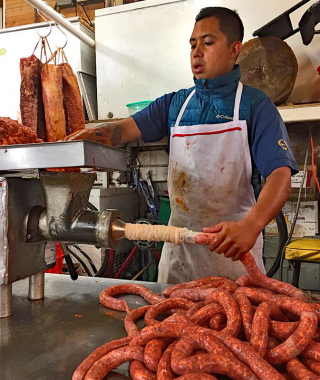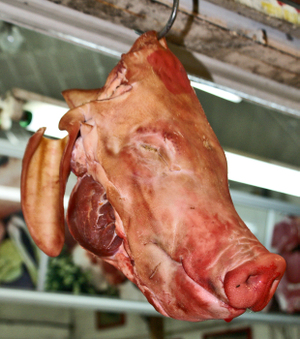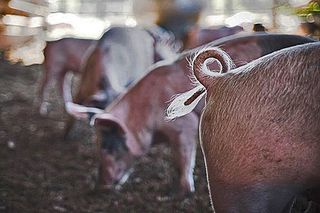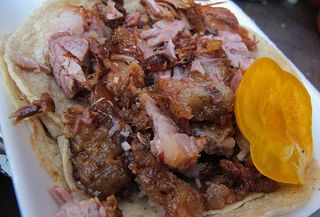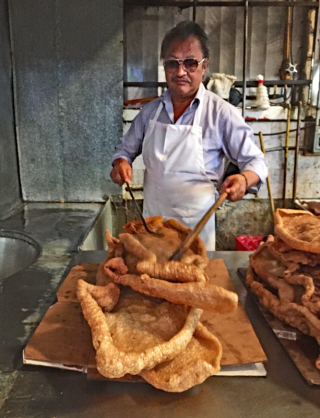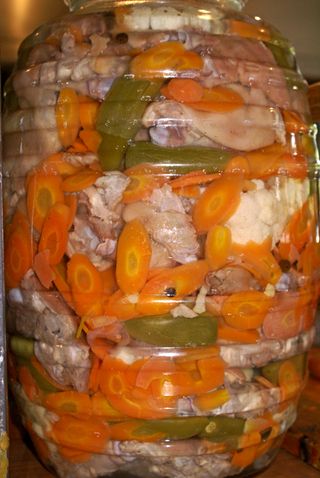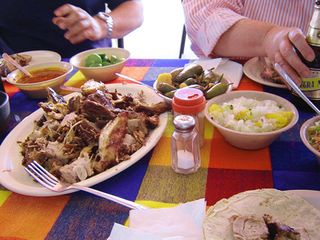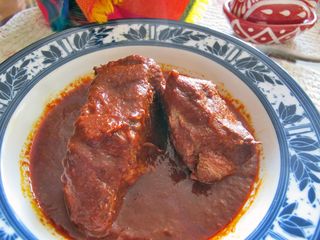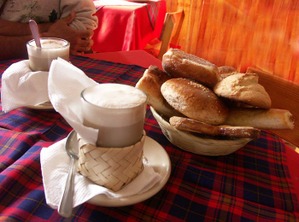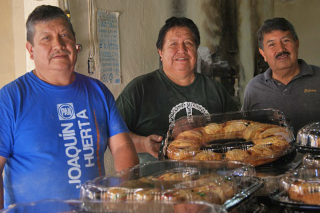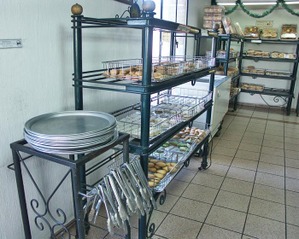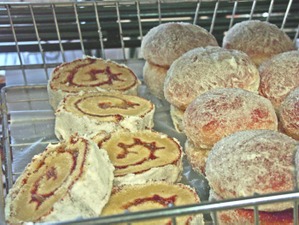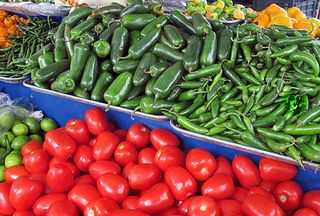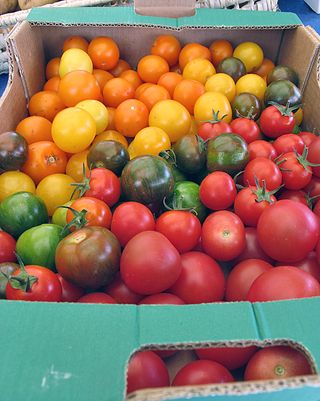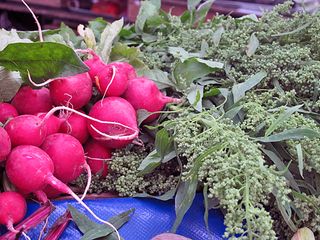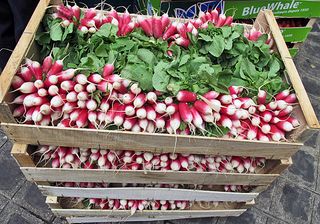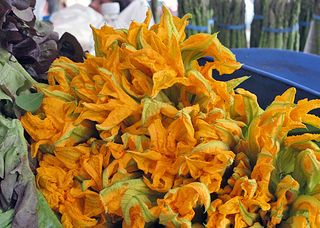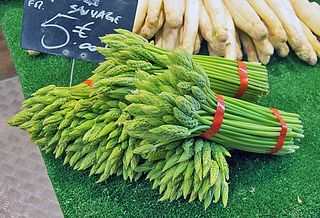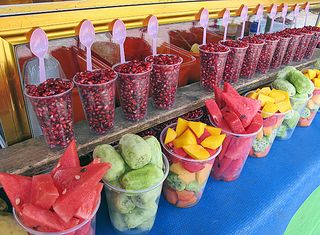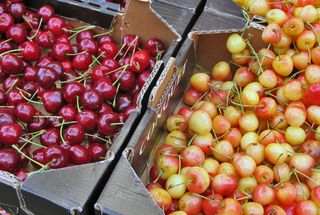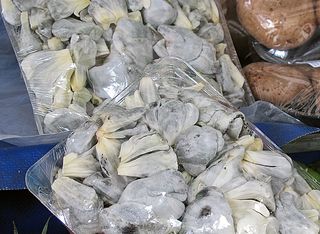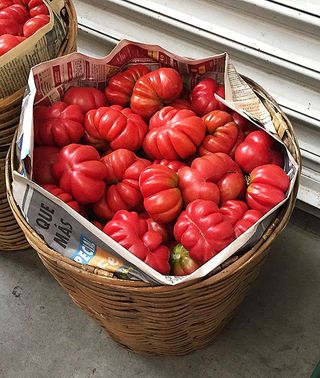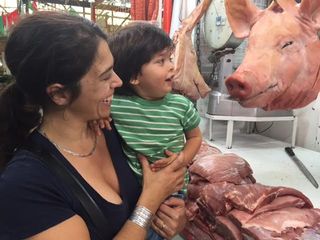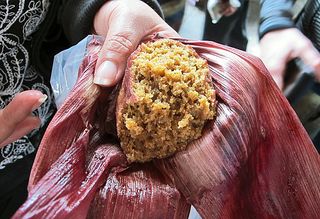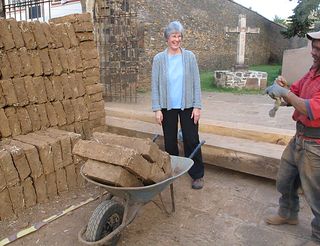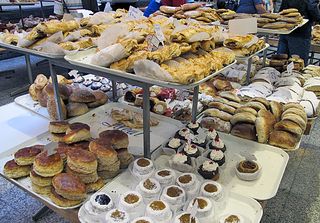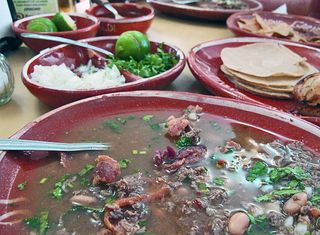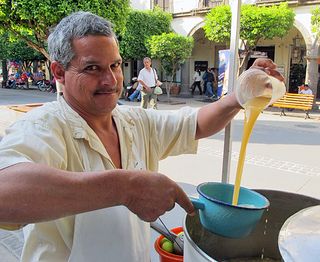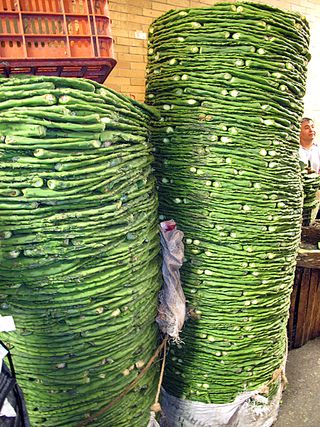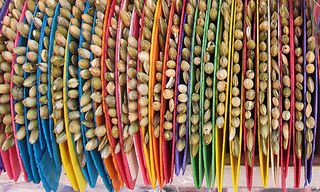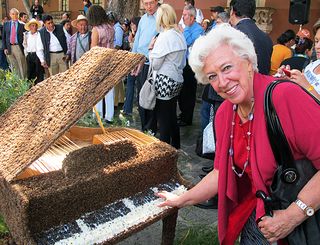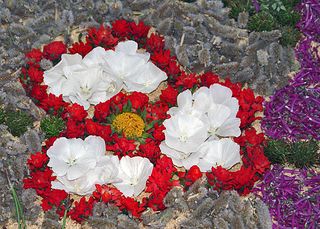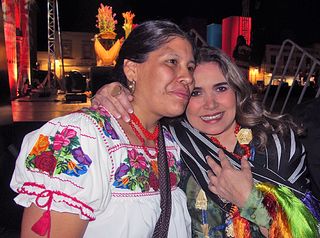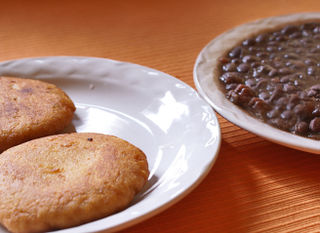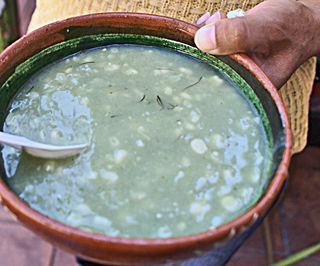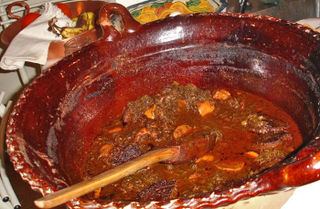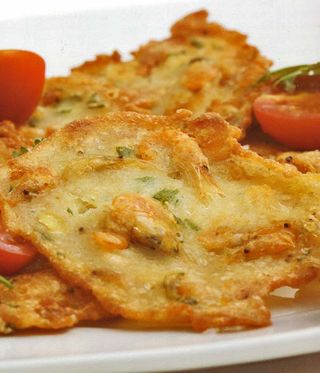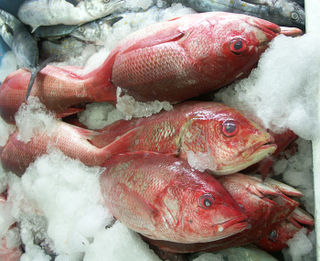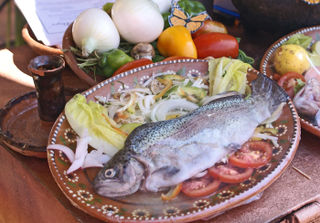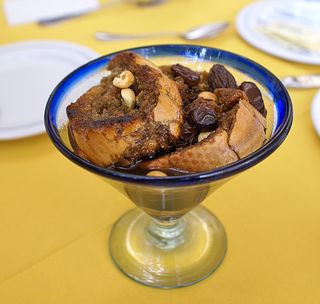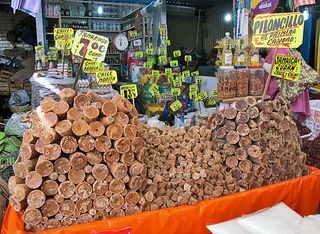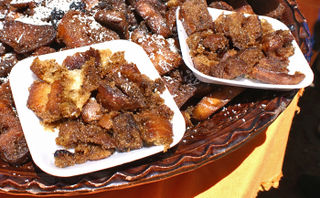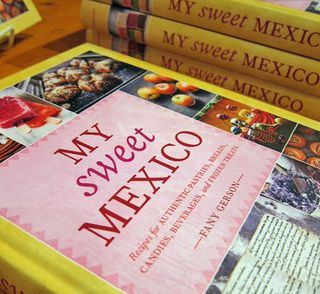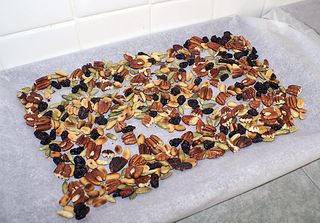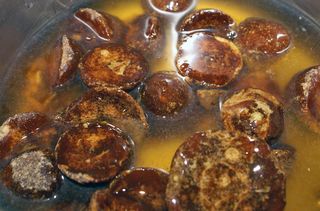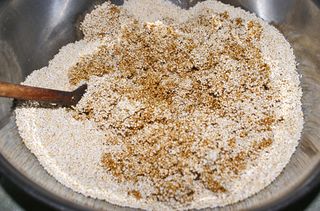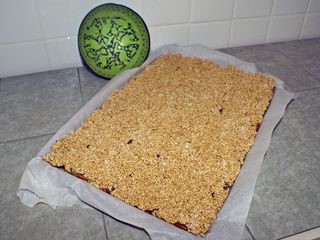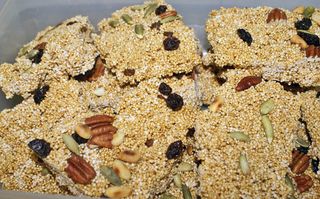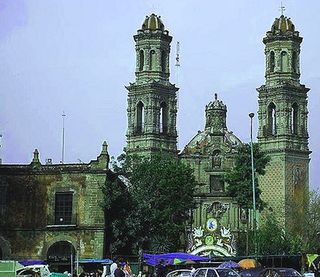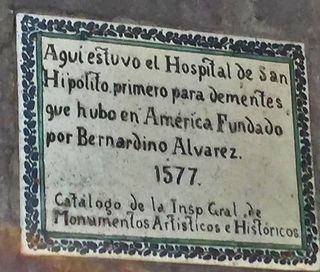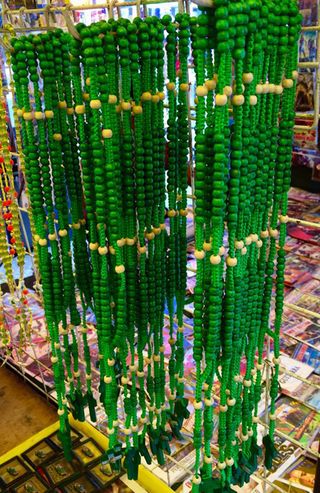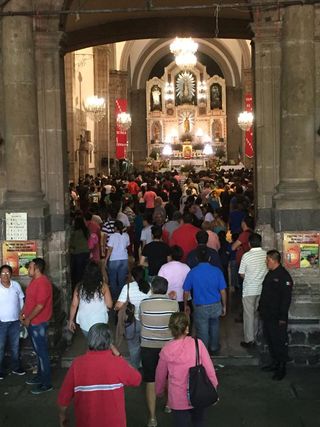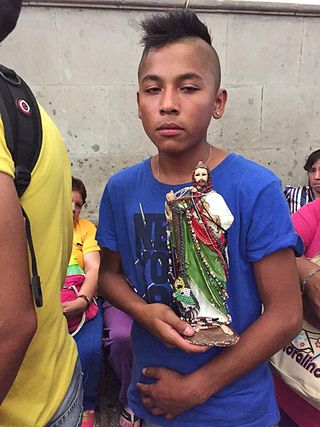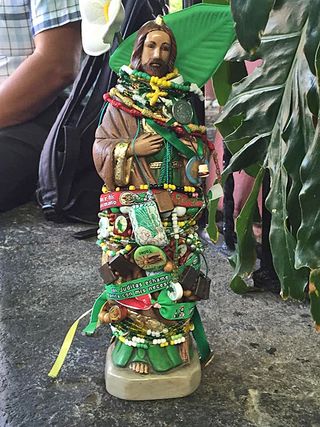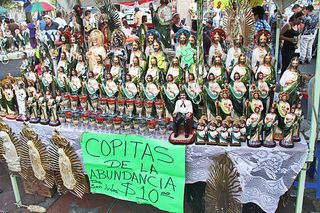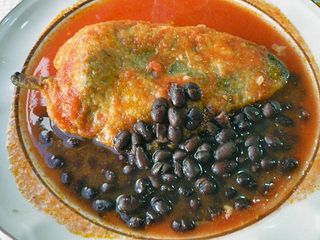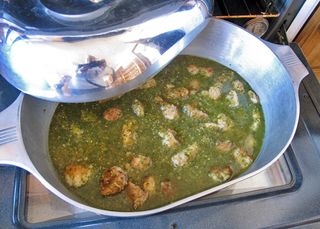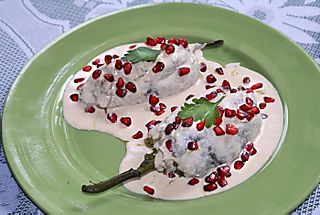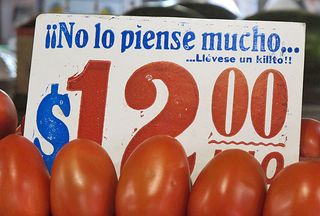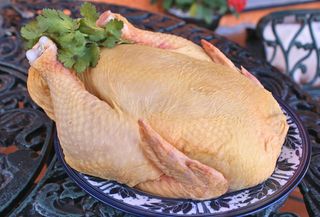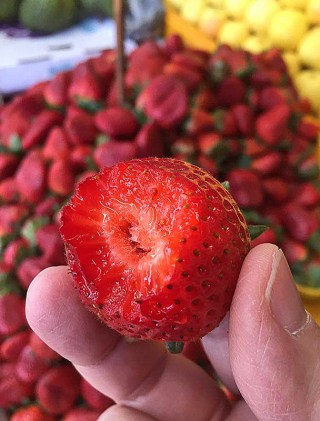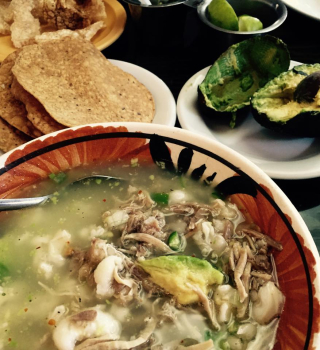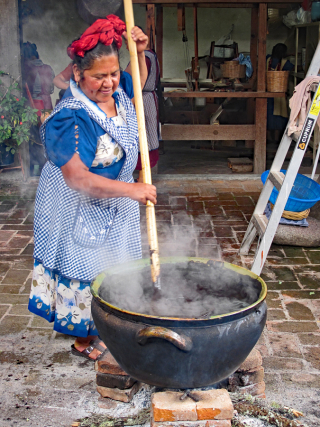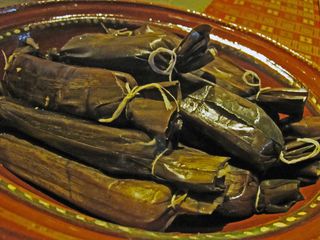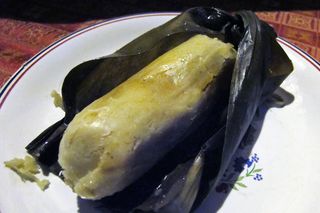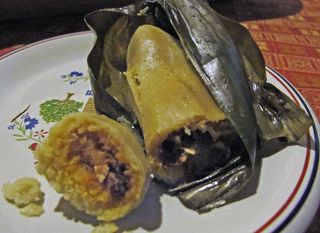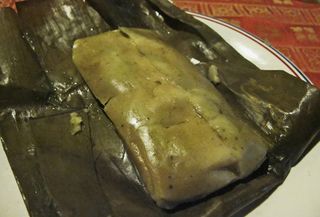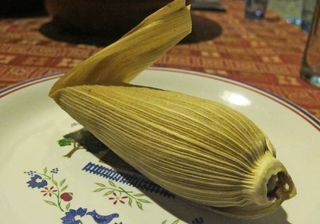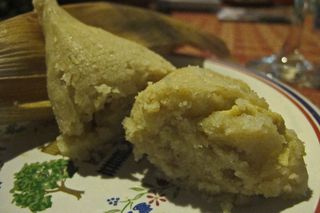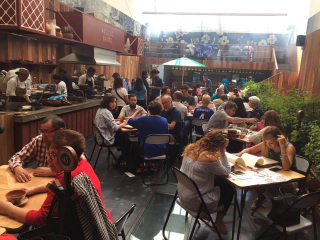
Restaurante Pasillo de Humo, Mexico City: casa llena (full house) recently at midday. The name of the restaurant means "hall of smoke"; it's borrowed from the name of an iconic section of the 20 de noviembre market in the city of Oaxaca. In that section–the pasillo de humo–one chooses fresh meat from any of a number of butchers, who grill it for you on the spot, along with tail-and-all bulb onions. The "hall of smoke" is always smoky, and always delicious; vendors sell wonderful side dishes, the seating is in booths that line the hall's sides, and the diners' spirits are always alegre (joyful). The Mexico City restaurant, just over two years old, isn't filled with smoke, of course, but it's almost always filled with joyful eaters at every meal: desayuno (breakfast), comida (Mexico's midday main meal of the day), and cena (supper).

One butcher's grill in Oaxaca's Mercado 20 de noviembre, pasillo de humo.
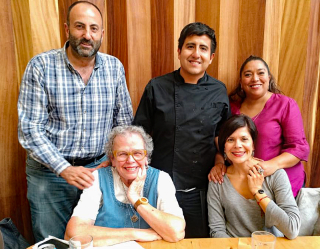
Mexico Cooks! was at Restaurante Pasillo de Humo for comida with the above group on November 2018–easily the 50 or 60th meal I've eaten there during the year since the restaurant opened. Clockwise from bottom left: Mexico Cooks!, (standing) Rafael Mier, founder of the 330,000+ member strong Facebook group Tortilla de Maíz Mexicana, chef Alam Méndez Florián, Lourdes Rosas, and (seated) Alondra Maldonado, Nayarit-based author of the cookbook Sabores de Nayarit (Flavors of Nayarit) who also teaches Mexican cooking classes. The restaurant serves day in and day out what I consider to be the best food in Mexico City. Given that there are plus or minus 15,000 restaurants in this enormous city, that's really saying something.
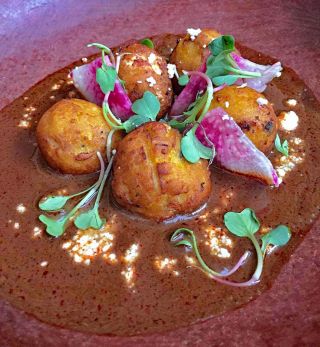
Our group of four ordered four appetizers to share. The first to come to table were these Oaxacan molotes, small spheres of very ripe, sweet plantains, mashed and formed into spheres. The spheres are then stuffed with queso fresco (light, fresh cheese); the indentation for the cheese is covered with a smear of plantain pulp, and the spheres are fried until light golden brown, just as you see them in the photo. These are plated in a thin pool of delicious mole, scattered with queso fresco, and topped with thin watermelon radish slices and sprouts.
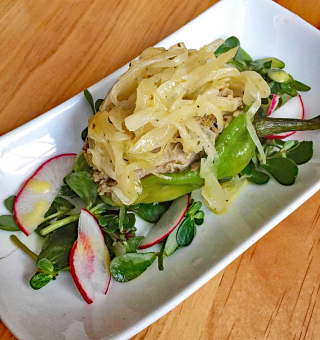
The second of our four appetizers: this is a fresh chile de agua ('water' chile, brought fresh from Oaxaca to Pasillo de Humo), slightly pickled, split open, and stuffed with marvelously seasoned shredded beef, then topped with pickled white onions.
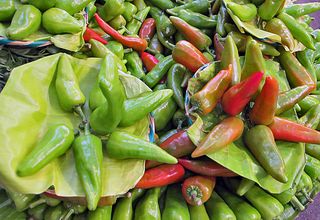
Fresh chiles de agua for sale in a Oaxaca market. Their color range is from pale green to bright red, as you see in the photo.
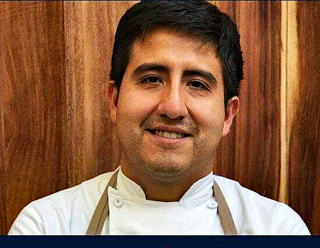
Alam David Méndez Florián, the young chef at Pasillo de Humo, has been immersed since birth in a world of traditional Oaxacan cooks, their superb old-time recipes that continue to thrill our palates, and their determination to maintain the food legacy passed to them from their elders. His parents, Fidel Méndez Sosa and traditional cook Celia Florián, opened their family's restaurant Las 15 Letras in the city of Oaxaca more than 25 years ago, when little Alam was only two years old. He started helping in the restaurant when he was scarcely as tall as the broom he used to sweep and all but stood on a box to reach the sink where he washed dishes. He says, "When I was about 11 years old, I started doing more: I could make the agua fresca del día (the day's fresh fruit water) or a salsa. I realized then that I really, really liked the kitchen."
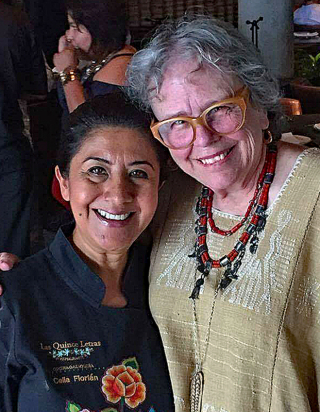
Mexico Cooks! with Celia Florián, chef Alam's mother and the inspiration for Restaurante Pasillo de Humo. Señora Florián is one of the most kind and loving people I know. Everyone who knows her considers her their dear friend, and I'm privileged to be in that group. She has two enormous gifts that anyone who knows her would tell you: that of truly being present to the person to whom she is speaking–and truly loving her native Oaxaca and its food and traditions.
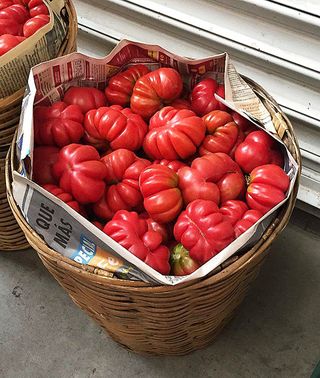
Among other ingredients that grow or are made best in Oaxaca, chef Alam brings these jitomates riñon (kidney-shaped tomatoes), several kinds of special chiles, dried corn to be nixtamal-ized and made into tortillas in the restaurant, meats such as thinly sliced tasajo (seasoned beef) and cecina (seasoned pork) for tlayudas (large, thin Oaxaca corn tortillas stuffed with quesillo (Oaxaca cheese), made in Oaxaca, special herbs, asiento (a kind of deeply flavored pork lard that is smeared onto the tlayuda), and many other items that are impossible to find in Mexico City's markets–even those that carry the most exotic items. It's hard to write this paragraph–my mouth keeps watering!
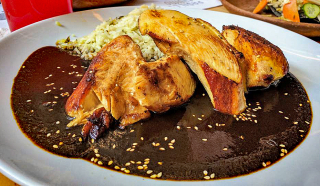
We ordered four platillos fuertes (main dishes) to share. Delicious, tender, perfectly cooked roast chicken breast in a pool of el rey de los moles (the king of moles): Oaxaca mole negro (black mole), made with chile chilhuacle negro (dried black chile chilhuacle), brought to the restaurant from Oaxaca.

Premium first class chile chilhuacle in a Oaxaca market. The name on the sign is a spelling variation for this chile.
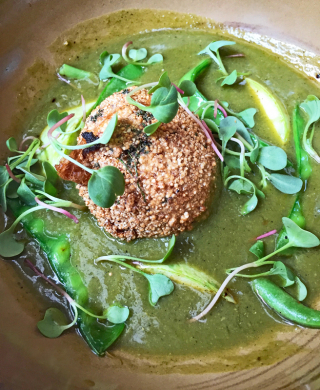
One of my very favorite dishes at Pasillo de Humo: the chef calls it an albóndiga, but meatball it's not. The crust is crushed corn and amaranth. Inside, it contains huahuazontle (a prehispanic vegetable similar to amaranth), quesillo (aka Oaxaca cheese), and slightly spicy chile. The almost tennis-ball size albóndiga is deep fried until golden and served in a dish of Oaxacan mole verde with fresh, still-crisp green beans, fresh snow peas, slices of chayote, and little edible sprouts. Be still my heart.
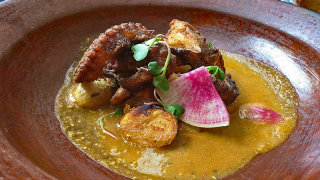
Third came pulpo en huaxmole (tender octopus in a chile costeño mole thickened with ground guaje seeds and served with tiny halved potatoes. Garnished with very thin watermelon radish slices and sprouts, this dish is perfectly prepared every time.
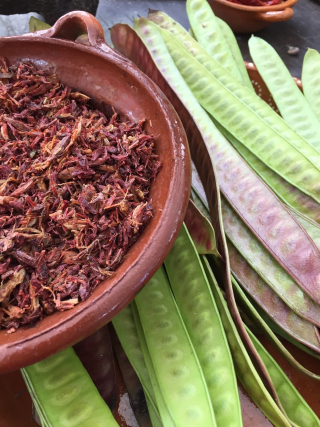
The long green pods are guajes (pronounced WAH-hehs), endemic to Oaxaca–and from which Oaxaca got its name. The seeds are removed for for thickening huaxmole. In the other dish? Tiny roasted chapulines (grasshoppers).
Chef Alam told me that in addition to his lifelong experience cooking with his mother, grandmother, and other family members, he studied professionally at the Instituto Culinario de México in Puebla, collaborating with chef Ángel Vázquez in the restaurant "Intro" for three years. Later, he competed as part of the National Junior Culinary Olympic Team, in Germany. When he finished his courses at the Instituto, he worked at the fabled two-Michelin-star restaurant Can Fabes in Barcelona, Spain and then at Arzak, in San Sebastian, which at the time had three Michelin stars.
In May 2014 chef Alam won "Most Promising Young Chef" in the competition Gastronómica Rivera del Duero, which took place in Mexico City. Later he worked as sous chef in the Hotel Santa Cruz Plaza in Chile. Sometime later he developed the kitchen and the menu for restaurant Don Porfirio in Guatemala and continued as its executive chef during its first year of operations. Following that, he was
production chef with Rosío Sánchez in her taco shop Hija de Sánchez in Copenhagen, just prior to starting Pasillo de Humo.
Just recently, he was nominated for "Most Promising Chef" in the 2017 Gourmet awards, as "up and coming chef" in Food & Travel México's 2017 Reader Awards, and as semifinalist in the San Pellegrino Young Chef 2018.
In addition to his work at Pasillo de Humo, chef Alam and a team of investors and assistants have just opened the new restaurant Urbano 116 in Alexandria, Virginia. But be assured that the deliciousness continues at Pasillo de Humo! Chef Alam and his mother, cocinera tradicional Celia Florián, are still "in the house" here in Mexico City: Alam one week, then a week of off-site supervision, then Sra. Florián for a week. I've been several times since mid-December and am here to tell you it's just as fantastic as always.
Chef Alam has become enormously accomplished in his relatively short career. It's a joy to see that he continues to credit his parents and his beginnings at home for so much of his success.
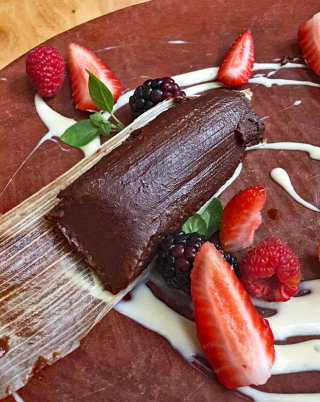
Some people say, "If it's dessert, it has to be chocolate." This tamal de chocolate definitely filled that bill. Plump and rich with Oaxacan chocolate, these tender, fluffy tamales are steamed in corn husks and served still hot. This was to have been our only shared dessert, paired with three flavors of house-made ice cream (a small scoop each of vanilla with chile, burned milk, and poleo (a Oaxacan herb), but suddenly the kitchen brought two extra desserts–oh, poor us!
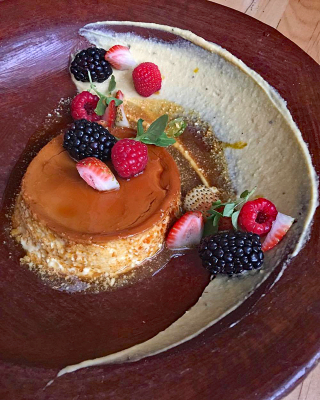
Our second dessert: a traditional flan, about to be included in the menu at Pasillo de Humo. Creamy, made with cream cheese and not quite as light as the standard custard-style flan, this one knocked all our socks off.
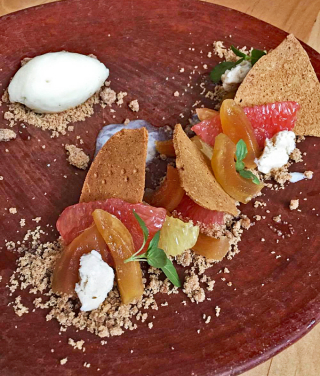
This new dessert, coming soon to the menu at Pasillo de Humo, is an exquisite blend of crunchy, chewy, juicy, sweet, tart, and is fabulous. Chef Alam created it and named it xoconostle en tacha. He nixtamalizes the xoconostle, a tart and sour relative of Mexico's seasonal tuna (sweet cactus fruit), to firm up its texture; then he slowly cooks it in a piloncillo (Mexican raw sugar cones) and canela (cinnamon) flavored thick syrup until the sour fruit is permeated with the intensely sweet syrup. On the plate, he combines the now-sweet, slightly chewy xoconostle with juicy slices of pink and yellow grapefruit, crunchy "tierra" (the crumbly, buttery base), a bit of queso fresco, some crisp butter cookies, and a scoop of helado de guayaba (guava ice cream). Don't ask, okay? I could have licked the plate, and you'll want to as well.
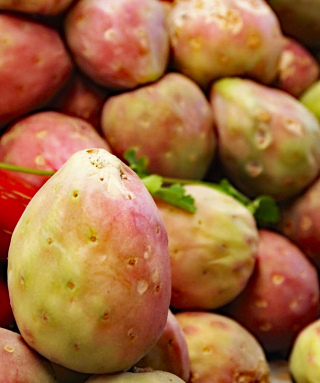
Recently harvested xoconostles. You can easily see where the needle-sharp thorns have been removed from the fruit's skin.

In addition to wonderful food, Oaxaca (and Pasillo de Humo) are also renowned for mezcal, an alcoholic beverage distilled from earthen-oven baked maguey cactus. Before or after your meal, ask for the mezcal cart–a repurposed diablito (hand truck). Your server will pour you little sips of any mezcal you'd like to taste. When you choose the one you prefer, your serving will be bigger!
Provecho! You're going to fall in love with Restaurante Pasillo de Humo. Look around for me, it would be a pleasure to meet you.
Restaurante Pasillo de Humo
Upstairs at Parián Condesa
Av. Nuevo León 107, near the corner of Calle Michoacán
Colonia Hipódromo Condesa
Mexico City, Mexico
Telephone (from outside Mexico) 011-52-55-5211-7263
Reservations necessary and can only be made by phone.
Hours:
Monday, Tuesday, Wednesday 9:00AM to 10:00PM
Thursday, Friday, Saturday 9:00AM to 11:00PM
Sunday: 9:00AM to 7:00PM
Looking for a tailored-to-your-interests specialized tour in Mexico? Click here: Tours.
